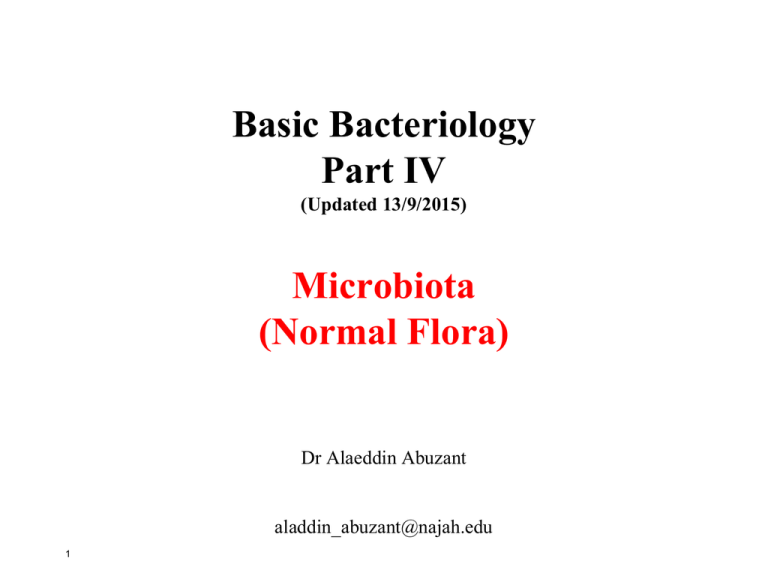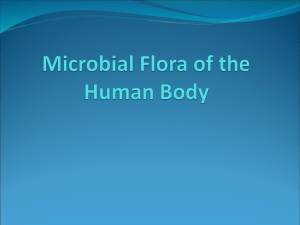4-Basic Bacteriology-Part-IV
advertisement

Basic Bacteriology Part IV (Updated 13/9/2015) Microbiota (Normal Flora) Dr Alaeddin Abuzant aladdin_abuzant@najah.edu 1 Symbiosis: is defined as the association (living together) of two or more different species. During this association, physical contact and dynamic interactions occur between the organisms involved in symbiosis. Symbiosis usually occurs between a small organism that associates with a larger one The smaller organism is know as Symbiont The lager organism is known as the Host Symbionts can be either: Ectosymbiont: A symbiont that survives on the surface of the host Endosymbiont: A symbiont that survives within the host ((at certain anatomical location (s)) 2 Types of Symbiotic Relationships: 1- Mutualism (Mutual Symbiosis): the Symbiotic relationships between organisms is known as Mutualism when both partners (Symbiont and Host) have reciprocal benefits out of this symbiotic relationships . In other words, Mutualism is kind of an obligatory symbiotic relationship because the partners depend (in a way another) on each other and cannot live separately. 2- Commensalism: the Symbiotic relationship between organisms is known as Commensalism when one of the partners (Symbiont and Host) gain benefits out of this symbiotic relationships but the other partner is not harmed. 3- Parasitism: the Symbiotic relationship between organisms is known as Parasitism when one of the partners (the Symbiont) gains benefits out of this symbiotic relationships but the other partner (host) is harmed. In this sense, any organism that can cause disease in human, can be named generally as Parasite (as a general name) ( such as bacteria, viruses, fungi, worms, protozoa)( they may also be called as Pathogens as a general name as well) Note: the study the of diseases that are caused by protozoa and worms is known as Parasitology (A branch of Microbiology). In this science, these organisms (protozoa and worms) are called parasites Microbiota (Old name: Normal Flora) Microbiota: This term is used to describe the various bacteria and fungi (Symbionts) that are permanent residents of certain body anatomical sites the Host. (Note: Candida albicans is the only fungal member of the human microbiota ) The Symbionts that represent the microbiota of a host are often referred to as commensals, because (in most cases), they gain benefits from the host without causing any harm. (some member of the microbiota may have a mutualism symbiotic relationship with the host) Note: All multicellular organism harbor microbiota at certain anatomical locations of their bodies (insects, all animals and humans) Note: Although they can be present in asymptomatic individuals ,viruses and parasites, are not considered members of the normal flora Human Microbiota (Normal Flora) Human body harbors billions and billions of bacteria at certain anatomical locations such as: 1- Skin 2- Oral cavity 3- Upper Respiratory tract (nasal cavities, though, upper part of the trachea) 4- Colon (large intestine) 5- The last parts of the urogenital tact (urethra, vagina) It is estimated that the number of bacterial cells that each human harbors are more the number of cells that build up the human body. Reasons to Study Normal Human Microbiota: To have more knowledge an understanding regarding the advantages and potential disadvantages of human microbiota: Advantages: 1- Development of the immune system (experiments have shown that germ-free mice ( also known as Axenic /Gnotobiotic mice) develop a poor immune system 2- Production of certain vitamins (vitamins B and K) 3- Interfere with colonization of primary pathogens (specially intestinal normal flora) Disadvantages: Some members of the human microbiota can cause disease in certain cases: 1- Weakening of the immune system 2- Translocation into a sterile body site that are not supposed be at (such as balder, kidneys, blood stream, lungs, peritoneal cavity, CNS, muscle tissue) 3- Overgrowth of some members of normal flora during antibiotic administration ( sensitive members of normal flora die while resistant members overgrow) Note: members of microbiota that can cause disease are known as opportunistic pathogens (secondary pathogens) Note: oral normal flora play an important role in dental caries (Germ-free mice DO NOT develop dental caries) The immune system keeps normal flora in check: Although our immune system allows normal flora to inhabit certain body locations , it keeps normal flora in check: Examples: Skin produces many inhibitory substances that limit bacterial growth such as sweat and certain fatty acids Lysosome that kills bacteria by (by destroying peptidoglycan) is secreted in saliva and tears The mucosa of digestive tract secrete antibodies (IgA) and antibiotic peptides that limits bacterial growth 9 It is important to note that members of the normal flora vary in both number and kind from one body site to another 10 Examples of human Microbiota (memorize the underlined ones only) A- Skin Normal Flora: Staphylococcus epidermidis : it is a non-pathogen on the skin. However, it can cause disease when it reaches certain sites such as artificial heart valves and prosthetic joints. (There are about 103–104 organisms/cm2 of skin). Propionibacterium : it is anaerobic bacterium that situated in the deeper follicles in the dermis where oxygen tension is low. Propionibacterium acnes is is implicated in the pathogenesis of acne. Candida albicans (yeast): is the only fungal member of the human normal flora. I may be found on skin, in mouth and in the colon . It can enter bloodstream when needles pierce the skin. It is an important cause of blood stream and systemic infections in immunocompromised patients. B- Normal flora of the oral cavity: 1- Viridans streptococci make up about half of the normal flora of the oral cavity such as: which is involved in dental caries a-Streptococcus mutans b-Certain species of viridans streptococci are considered as a leading cause of subacute bacterial endocarditis. These organisms can enter the bloodstream at the time of dental surgery and attach to damaged heart valves. 2- Eikenella corrodens, also part of the normal oral flora, causes skin and soft tissue infections associated with deep human bites. 3- Anaerobic bacteria, such as Bacteroides and Prevotella , which are found in the gingival crevices, where the oxygen concentration is very low. If aspirated, these organisms can cause lung abscesses, especially in debilitated patients with poor dental hygiene. 4-Porphyromonas gingivalis , causes peiodentitis that may result in loss of teeth C- Normal Flora of the Upper Respiratory Tract: A wide spectrum of bacteria colonize the nose and the throat (upper part of the respiratory tract). Note: lower bronchi, bronchiols and alveoli typically contain few, if any, organisms. 1- The nose is colonized by a variety of streptococcal and staphylococcal species. The most significant of which is Staphylococcus aureus , which is an important opportunistic pathogens that can cause many types of infections (most commonly, wound infections). From the nasal cavity, S. aureus may spread into other locations such as skin, throat and vagina. 2-The throat contains a mixture of nonpathogenic viridans streptococci, Neisseria species, Staphylococcus aureus and Staphylococcus epidermides. They play an important role in inhibiting colonization of certain important pathogens such as Streptococcus pyogenes and Neisseria meningitidis 3- Streptococcus pneumoniae: it is found in about 40-50% of human. It can be an important opportunistic pathogen that can cause, otitis media, sinusitis, lung infection and meningitis D- Normal Flora of the Intestinal Tract: In normal healthy people, the stomach contains few organisms primarily because of its low pH. The small intestine usually contains small numbers of streptococci, lactobacilli, and yeasts, particularly C. albicans. The colon is a major location of normal flora in the body. It is estimated that 1 gram of feces contain as many as 1011 bacteria The major bacteria found in the colon are listed in the following table More than 90% of the fecal flora are anaerobes, the most important of which is Bacteroides spp The most abundant facultative anaerobic bacteria are the coliforms of which Escherichia coli, Proteus, Klebsiella Several members of the colon normal flora play a significant role in extraintestinal infection (if translocated into sterile body sites) Example: E. coli : is the leading cause of urinary tract infections Bacteroides fragilis : is an important cause of peritonitis associated with perforation of the intestinal wall following trauma and appendicitis Enterococcus faecalis : is an important cause urinary tract infections and endocarditis D- Normal flora of the urogenital tract (lower part): Kidneys, ureters, and bladder are usually sterile and harbor almost no normal flora Some skin normal flora can be found in the last pat of urethra. In adult females, the vagina harbors Lactobacilli, which plays an important role in preventing or interfering with fungal infection. Adult females receiving certain types of antibiotic for sometime, may suffer from vaginal fungal infection as these antibiotics suppress the bacterial normal flora of the vagina allowing the fungi to colonize and cause infection (Candida) Some of the colon normal flora may also be found in the vagina ( because of the short anatomical distance between anus and vagina in females). Some of these may cause bacterial vaginitis and urinary tract infection (UTI) 16






